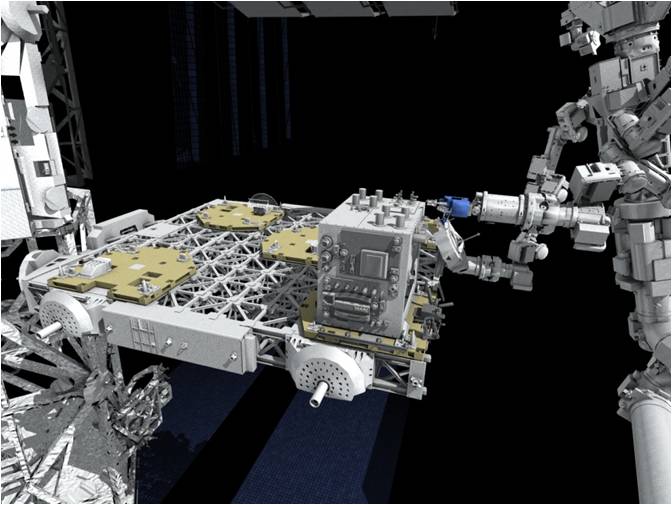NASA to Launch Robot Gas Station Experiment on Final Shuttle Flight

CAPE CANAVERAL, Fla. — Tucked amid the other gear inside the cargo bay of NASA's last space shuttle to fly will be a novel experiment: a robot gas station for spacecraft that, if successful, could change how satellites are designed.
NASA engineers are packing up the so-called Robotic Refueling Mission hardware and other equipment for delivery to the International Space Station on the shuttle Atlantis, which is set to fly July 8. The flight, STS-135, is NASA's last-ever shuttle mission to the station before the 30-year-old orbiter program is retired for good. [Gallery: Shuttle Atlantis' Last Launch Pad Trek]
Normally, when a satellite is launched into orbit it, is already carrying all the fuel for its entire mission onboard. Once that fuel runs out, the satellite's life is effectively over. That fact makes it tough for old satellites — as well as craft launched into the wrong orbit and ones that suffer a malfunction — to keep working. But this new in-space refueling project could change things.
Developed by NASA's Goddard Space Flight Center in Greenbelt, Md., the Robotic Refueling Mission experiment will include a set of tools that could not only gas up satellites in space, but also perform minor repairs.
This system's first test will be performed on the space station using the orbiting lab's Canadian-built Dextre robot to check its feasibility. The refueling test hardware includes simulated caps, valves, external thermal blankets and ethanol fuel, experiment designers said.
A complex experiment
It will be the Dextre robot's job to use its own set of specialized tools to try to access the refueling systems, officials added. Yet, on most satellites, similar valves and other equipment were never designed to be touched in space.
Get the Space.com Newsletter
Breaking space news, the latest updates on rocket launches, skywatching events and more!
"Due to how these satellites were initially assembled, the nature of this mission is very complex," said Benjamin Reed, NASA's deputy project manager of the Space Servicing Capabilities Project. "If this works out, whenever a satellite goes through this process, not only will it be refueled, it will also be modified so that now it can be refueled more readily."
If the system works as expected, the first actual mission to repair a satellite running low on fuel is scheduled for May 2013, NASA officials said. But that wouldn't be just another test flight; it would include a trip to visit a weather satellite slated to be decommissioned, they added.
For Atlantis' launch, the Robotic Refueling Mission hardware will be attached to a shelf-like external cargo platform in the shuttle's payload bay. Several other large spare parts for the space station will also ride along.
Atlantis' final flight

Atlantis's payload bay will also be carrying a pressurized cargo pod called the Rafaello Multi-Purpose Logistics Module, which will be filled with more supplies, equipment and experiments for the space station's six-person crew. As this is the last flight of the shuttle program, the cargo module has been modified to maximize the amount of payload that it can carry. [Most Memorable Space Shuttle Missions]
"We incorporated into this flight an additional stowage kit that allows us to have an additional 400 pounds of cargo bags around the ascent cone," said Mike Kinslow, payload flow manager for the Atlantis mission. "The other big change that was done was, a modification package was added to strengthen the racks so that we could add additional cargo bags close to the floor. This increased what each of these racks could carry by 200 pounds."
Atlantis is currently scheduled to launch on July 8 at 11:40 a.m. EDT. The shuttle's crew is made up entirely of veteran astronauts, including commander Chris Ferguson, pilot Doug Hurley and mission specialists Sandra Magnus and Rex Walheim.
NASA is retiring its three-shuttle fleet to make way for a new space exploration program aimed at landing astronauts on an asteroid by 2025. After the upcoming mission, Atlantis and its sister ships will be moved to museums for permanent public display.
Follow SPACE.com for the latest in space science and exploration news on Twitter @Spacedotcom and on Facebook.
Join our Space Forums to keep talking space on the latest missions, night sky and more! And if you have a news tip, correction or comment, let us know at: community@space.com.
